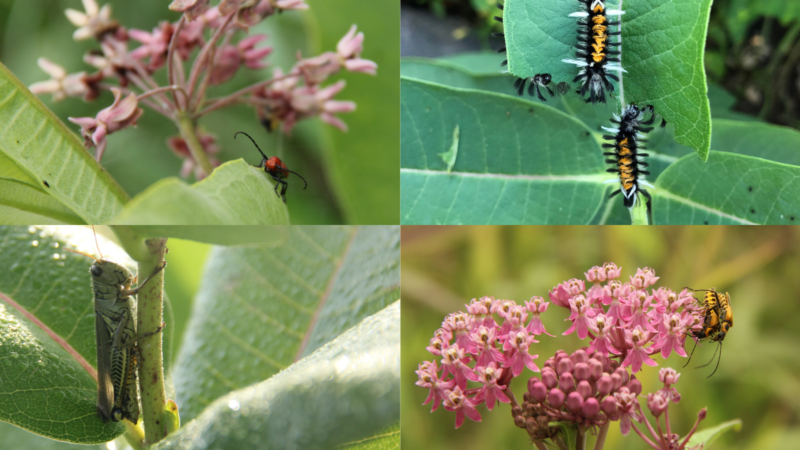
Why monarchs? While monarchs are intrinsically important, conserving monarchs matters for more than just their own protection. We’re exploring the ways that monarch habitat and conservation helps people, other wildlife and the environment in this ‘More than Monarchs’ series! Join us to learn more.
Insects and insect biodiversity help maintain a delicate balance within biological systems. Insects pollinate plants, help distribute seeds, and play an important role in the food web, just to name a few of their many contributions to our ecosystems (Scudder, 2017). Monarch butterflies are one of an estimated 91,000 different species of insects that exist within the United States today (Smithsonian). Luckily, much of the habitat and conservation work that we do for monarchs also positively supports insect biodiversity at large.
Planting milkweed, the only host species for monarchs, is a vitally important part of monarch conservation efforts. However, a milkweed patch planted for monarchs also creates habitat for hundreds of other insect species. Depending on where you live, some of the most common insects you might find in your milkweed patch in addition to a monarch butterfly include milkweed tussock moth caterpillars, red milkweed beetles, oleander aphids, and milkweed bugs (Lewis, 2015). But that’s just to name a few! In 1976, Patrick Dailey of Lewis and Clark Community College observed over 450 different species of insects visiting milkweeds (as cited in Lewis, 2005). Some were just temporary visitors, but many used milkweed as a source of nutrients, from munching on the leaves, stems, or roots of the plant, to collecting pollen and nectar from the flowers.
Monarch caterpillars eat milkweed, but adult butterflies require nectar plants as their food source during breeding seasons and to fuel their long fall and spring migrations. For the eastern population of monarchs, this journey can be as long as 3,000 miles! One of our favorite nectar plants here in the Midwest is the visually striking blazing star (Liatris spp.). Blazing star plants will certainly bring monarchs to your garden, but they also provide nectar and habitat for bees, flies, and other insects. In fact, liatris plants are the only known food source for two types of flower moths, Schinia gloriosa and Schinia sanguinea (Wheeler, 2017).
Wondering what nectar plants are best for your area? Check out these regional nectar-plant guides created by the Xerces Society, in partnership with Monarch Joint Venture and the National Wildlife Federation to find ideas of native flowers you can plant to support monarch butterflies and a host of other insects and pollinators. Shrubs, trees, vines, and forbs can all be helpful in supporting both monarchs and general insect biodiversity as well. To find out which plants are native to your area and provide valuable forage and shelter, check out these regional plant guides created by Pollinator Partnership and NAPPC.
When you plant milkweed and nectar plants for monarchs, your actions have the potential to impact hundreds of insects and other wildlife. When you speak up to maintain wildscapes in your area, you protect the ecological services necessary for us all to thrive.
Protecting habitat that supports insect biodiversity is just one example of how the work we do for monarchs can make a difference in many ways. What are the co-benefits of monarch conservation that matter most to you? Keep following our “More than Monarchs” series to hear more stories of what monarchs can do for us, our communities and our world.
Article written by Christine Sanderson (Monarch Joint Venture) with contributions from Gail Manning (Fort Worth Botanic Garden) for the Monarch Joint Venture Communications Working Group and NAPPC Monarch Taskforce’s More than Monarchs Series. The Monarch Joint Venture is a national partnership of federal and state agencies, non-governmental organizations, businesses and academic programs working together to conserve the monarch butterfly migration. The content in this article does not necessarily reflect the positions of all Monarch Joint Venture partners. Photos in the header by Wendy Caldwell.
References
Lewis, D. (2005, July). The milkweed insects. Iowa State University Extension and Outreach: News.
Lewis, D. (2015, July 10). Milkweed insects. Iowa State University Extension and Outreach: Horticulture and home pest news. https://hortnews.extension.iastate.edu/2015/07-10/milkweed.html
Scudder, G. G. E. (2017). The importance of insects: Science and society. R. G. Foottit & P. H. Adler (Eds.), Insect Biodiversity (pp.9-43). John Wiley & Sons. https://doi.org/10.1002/9781118945568.ch2
Smithsonian. (n.d.) Number of insects (species and individuals).
Wheeler, J. (2017, August 9). Plants for pollinators: Blazingstar. Xerces Society for Invertebrate Conservation. https://xerces.org/blog/plants-for-pollinators-blazingstar
